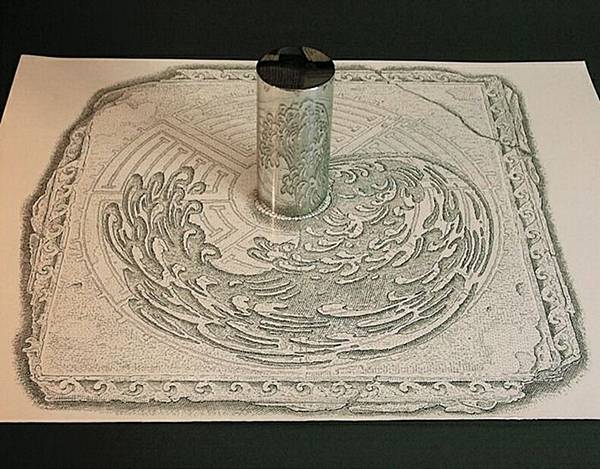Anamorphosis is a distorted projection or perspective requiring the viewer to use special devices or occupy a specific vantage point to reconstitute the image. "Ana - morphosis" comes from the Greek words meaning "formed again." More Images after the break...

Histroy Of Anamorphosis Leonardo's Eye (Leonardo da Vinci, c. 1485) is the earliest known example of perspective anamorphosis. Hans Holbein the Younger is well known for incorporating this type of anamorphic trick. His painting The Ambassadors is the most famous example for anamorphosis, in which a distorted shape lies diagonally across the bottom of the frame. Viewing this from an acute angle transforms it into the plastic image of a skull. During the 17th century, Baroque trompe l'oeil murals often used this technique to combine actual architectural elements with an illusion. When standing in front of the art work in a specific spot, the architecture blends with the decorative painting. The dome and vault of the Church of St. Ignazio in Rome, painted by Andrea Pozzo, represented the pinnacle of illusion. Due to complaints of blocked light by neighbouring monks, Pozzo was commissioned to paint the ceiling to look like the inside of a dome, instead of actually constructing one. However, the ceiling is flat, and there is only one spot where the illusion is perfect and a dome looks real.
In 18th and in 19th century, anamorphic images had come to be used more as children's games than fine art. In the 20th century some artists wanted to renew the technique of anamorphosis. Important to mention Marcel Duchamp's interest in anamorphosis, some of his installations are paraphrases of anamorphoses (See The Bride Stripped Bare by Her Bachelors, Even/The Large Glass). Salvador Dalí also utilized the effect in a number of his paintings. Jan Dibbets conceptual works, the so-called "perspective corrections" are examples of "linear" anamorphoses.
In 18th and in 19th century, anamorphic images had come to be used more as children's games than fine art. In the 20th century some artists wanted to renew the technique of anamorphosis. Important to mention Marcel Duchamp's interest in anamorphosis, some of his installations are paraphrases of anamorphoses (See The Bride Stripped Bare by Her Bachelors, Even/The Large Glass). Salvador Dalí also utilized the effect in a number of his paintings. Jan Dibbets conceptual works, the so-called "perspective corrections" are examples of "linear" anamorphoses.












No comments:
Post a Comment